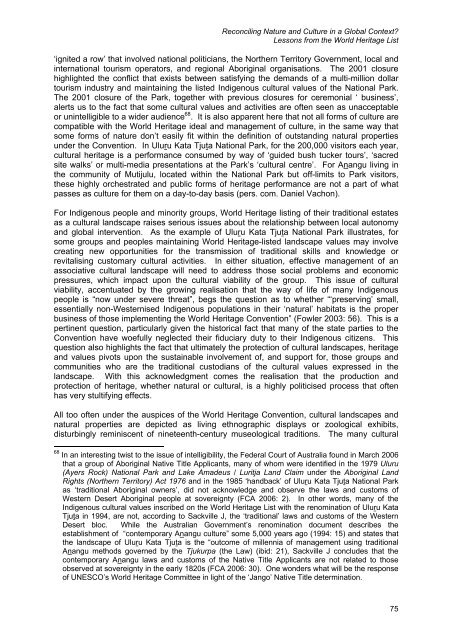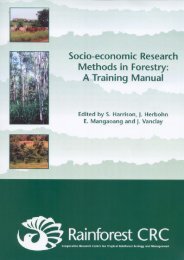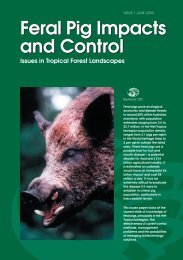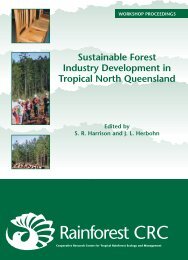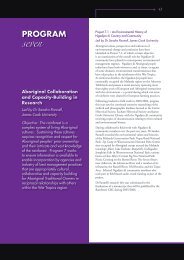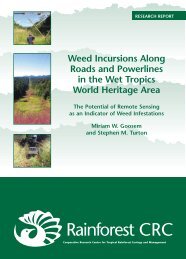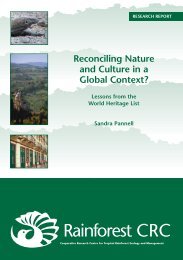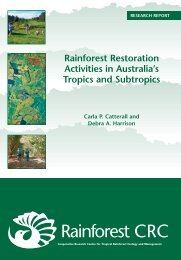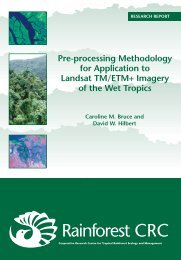Reconciling Nature and Culture in a Global Context? - Rainforest ...
Reconciling Nature and Culture in a Global Context? - Rainforest ...
Reconciling Nature and Culture in a Global Context? - Rainforest ...
You also want an ePaper? Increase the reach of your titles
YUMPU automatically turns print PDFs into web optimized ePapers that Google loves.
<strong>Reconcil<strong>in</strong>g</strong> <strong>Nature</strong> <strong>and</strong> <strong>Culture</strong> <strong>in</strong> a <strong>Global</strong> <strong>Context</strong>?Lessons from the World Heritage List‘ignited a row’ that <strong>in</strong>volved national politicians, the Northern Territory Government, local <strong>and</strong><strong>in</strong>ternational tourism operators, <strong>and</strong> regional Aborig<strong>in</strong>al organisations. The 2001 closurehighlighted the conflict that exists between satisfy<strong>in</strong>g the dem<strong>and</strong>s of a multi-million dollartourism <strong>in</strong>dustry <strong>and</strong> ma<strong>in</strong>ta<strong>in</strong><strong>in</strong>g the listed Indigenous cultural values of the National Park.The 2001 closure of the Park, together with previous closures for ceremonial ‘ bus<strong>in</strong>ess’,alerts us to the fact that some cultural values <strong>and</strong> activities are often seen as unacceptableor un<strong>in</strong>telligible to a wider audience 68 . It is also apparent here that not all forms of culture arecompatible with the World Heritage ideal <strong>and</strong> management of culture, <strong>in</strong> the same way thatsome forms of nature don’t easily fit with<strong>in</strong> the def<strong>in</strong>ition of outst<strong>and</strong><strong>in</strong>g natural propertiesunder the Convention. In Uluru Kata Tjuta National Park, for the 200,000 visitors each year,cultural heritage is a performance consumed by way of ‘guided bush tucker tours’, ‘sacredsite walks’ or multi-media presentations at the Park’s ‘cultural centre’. For Anangu liv<strong>in</strong>g <strong>in</strong>the community of Mutijulu, located with<strong>in</strong> the National Park but off-limits to Park visitors,these highly orchestrated <strong>and</strong> public forms of heritage performance are not a part of whatpasses as culture for them on a day-to-day basis (pers. com. Daniel Vachon).For Indigenous people <strong>and</strong> m<strong>in</strong>ority groups, World Heritage list<strong>in</strong>g of their traditional estatesas a cultural l<strong>and</strong>scape raises serious issues about the relationship between local autonomy<strong>and</strong> global <strong>in</strong>tervention. As the example of Uluru Kata Tjuta National Park illustrates, forsome groups <strong>and</strong> peoples ma<strong>in</strong>ta<strong>in</strong><strong>in</strong>g World Heritage-listed l<strong>and</strong>scape values may <strong>in</strong>volvecreat<strong>in</strong>g new opportunities for the transmission of traditional skills <strong>and</strong> knowledge orrevitalis<strong>in</strong>g customary cultural activities. In either situation, effective management of anassociative cultural l<strong>and</strong>scape will need to address those social problems <strong>and</strong> economicpressures, which impact upon the cultural viability of the group. This issue of culturalviability, accentuated by the grow<strong>in</strong>g realisation that the way of life of many Indigenouspeople is “now under severe threat”, begs the question as to whether “‘preserv<strong>in</strong>g’ small,essentially non-Westernised Indigenous populations <strong>in</strong> their ‘natural’ habitats is the properbus<strong>in</strong>ess of those implement<strong>in</strong>g the World Heritage Convention” (Fowler 2003: 56). This is apert<strong>in</strong>ent question, particularly given the historical fact that many of the state parties to theConvention have woefully neglected their fiduciary duty to their Indigenous citizens. Thisquestion also highlights the fact that ultimately the protection of cultural l<strong>and</strong>scapes, heritage<strong>and</strong> values pivots upon the susta<strong>in</strong>able <strong>in</strong>volvement of, <strong>and</strong> support for, those groups <strong>and</strong>communities who are the traditional custodians of the cultural values expressed <strong>in</strong> thel<strong>and</strong>scape. With this acknowledgment comes the realisation that the production <strong>and</strong>protection of heritage, whether natural or cultural, is a highly politicised process that oftenhas very stultify<strong>in</strong>g effects.All too often under the auspices of the World Heritage Convention, cultural l<strong>and</strong>scapes <strong>and</strong>natural properties are depicted as liv<strong>in</strong>g ethnographic displays or zoological exhibits,disturb<strong>in</strong>gly rem<strong>in</strong>iscent of n<strong>in</strong>eteenth-century museological traditions. The many cultural68 In an <strong>in</strong>terest<strong>in</strong>g twist to the issue of <strong>in</strong>telligibility, the Federal Court of Australia found <strong>in</strong> March 2006that a group of Aborig<strong>in</strong>al Native Title Applicants, many of whom were identified <strong>in</strong> the 1979 Uluru(Ayers Rock) National Park <strong>and</strong> Lake Amadeus / Luritja L<strong>and</strong> Claim under the Aborig<strong>in</strong>al L<strong>and</strong>Rights (Northern Territory) Act 1976 <strong>and</strong> <strong>in</strong> the 1985 ‘h<strong>and</strong>back’ of Uluru Kata Tjuta National Parkas ‘traditional Aborig<strong>in</strong>al owners’, did not acknowledge <strong>and</strong> observe the laws <strong>and</strong> customs ofWestern Desert Aborig<strong>in</strong>al people at sovereignty (FCA 2006: 2). In other words, many of theIndigenous cultural values <strong>in</strong>scribed on the World Heritage List with the renom<strong>in</strong>ation of Uluru KataTjuta <strong>in</strong> 1994, are not, accord<strong>in</strong>g to Sackville J, the ‘traditional’ laws <strong>and</strong> customs of the WesternDesert bloc. While the Australian Government’s renom<strong>in</strong>ation document describes theestablishment of “contemporary Anangu culture” some 5,000 years ago (1994: 15) <strong>and</strong> states thatthe l<strong>and</strong>scape of Uluru Kata Tjuta is the “outcome of millennia of management us<strong>in</strong>g traditionalAnangu methods governed by the Tjukurpa (the Law) (ibid: 21), Sackville J concludes that thecontemporary Anangu laws <strong>and</strong> customs of the Native Title Applicants are not related to thoseobserved at sovereignty <strong>in</strong> the early 1820s (FCA 2006: 30). One wonders what will be the responseof UNESCO’s World Heritage Committee <strong>in</strong> light of the ‘Jango’ Native Title determ<strong>in</strong>ation.75


